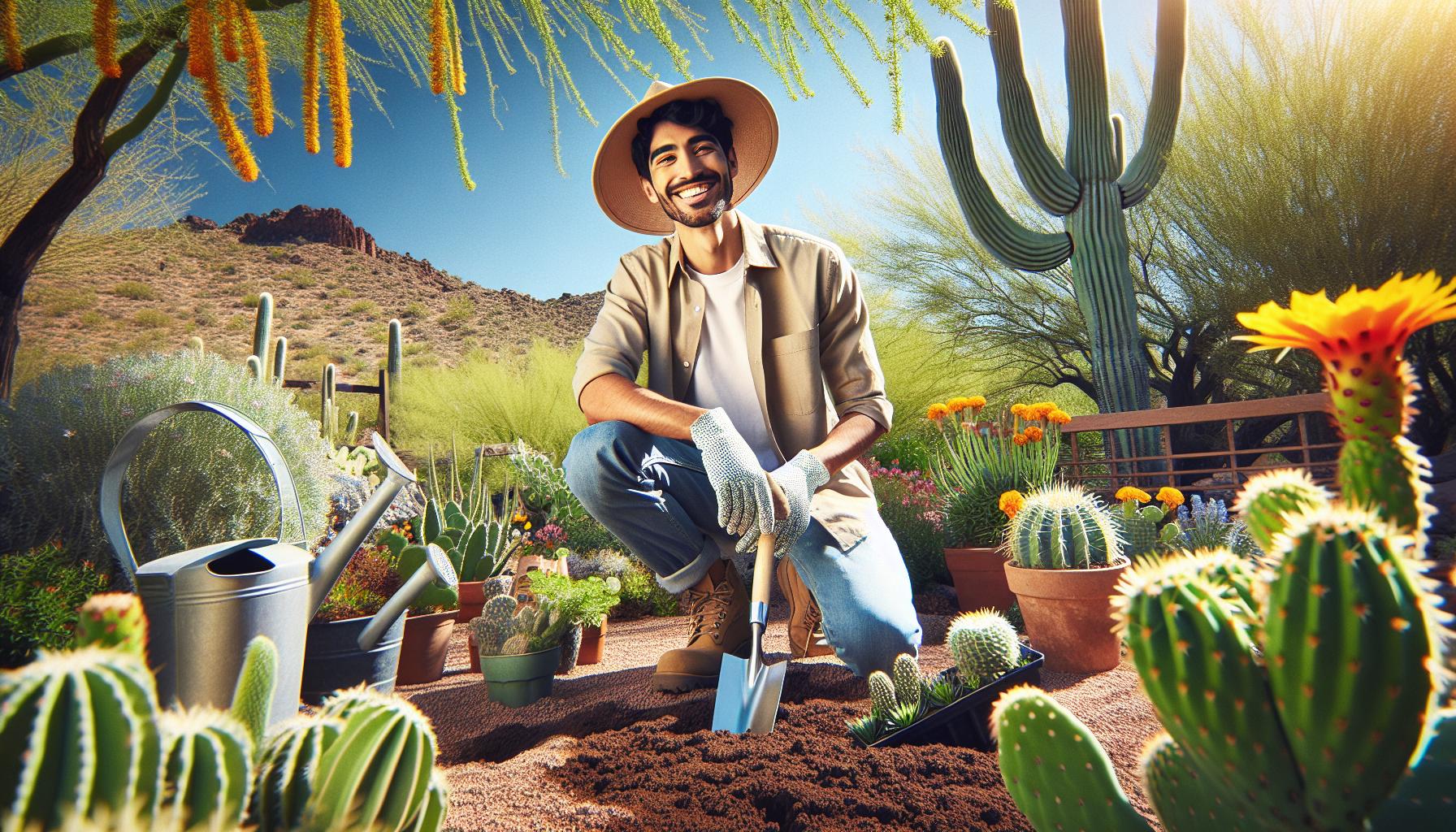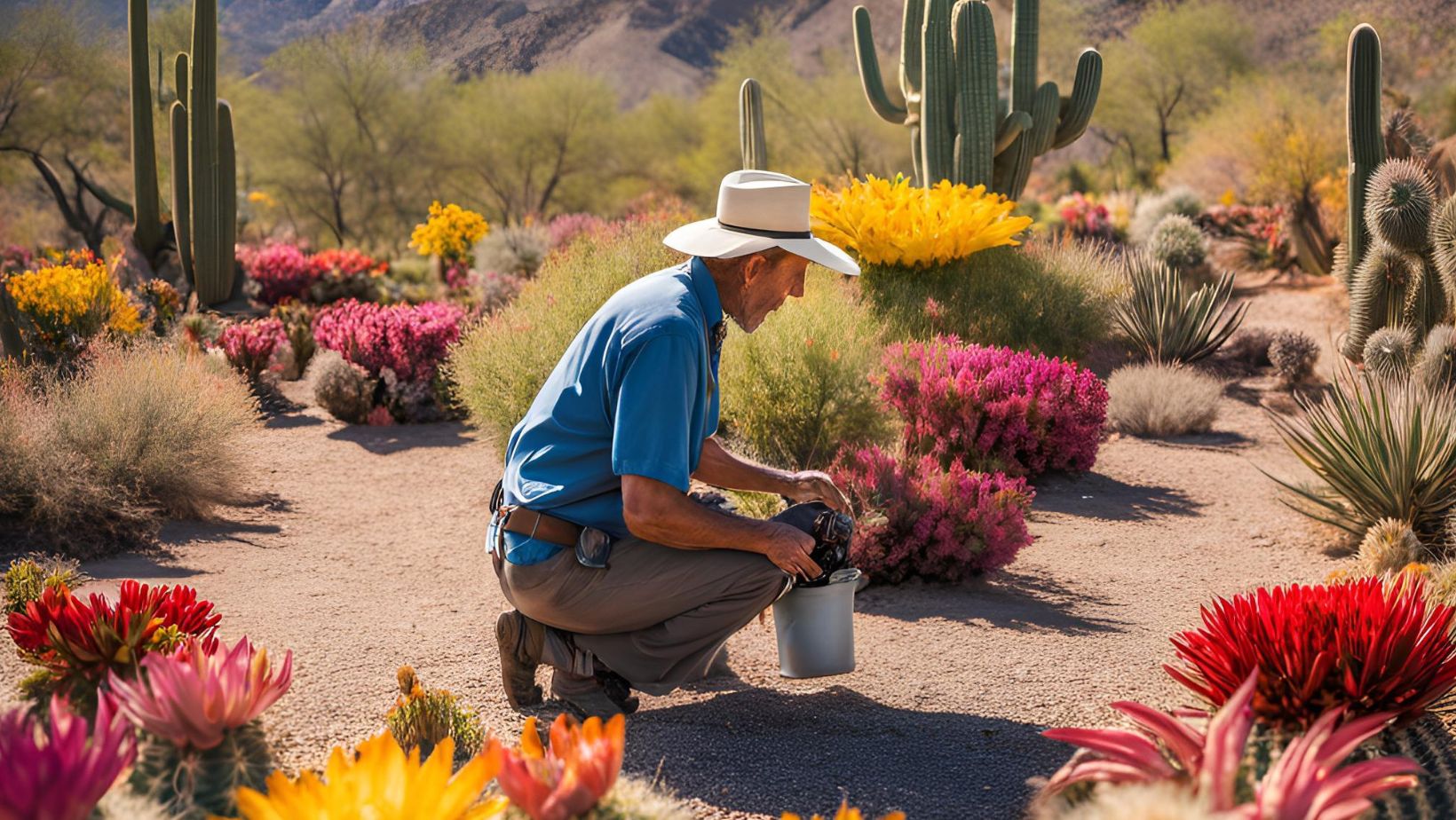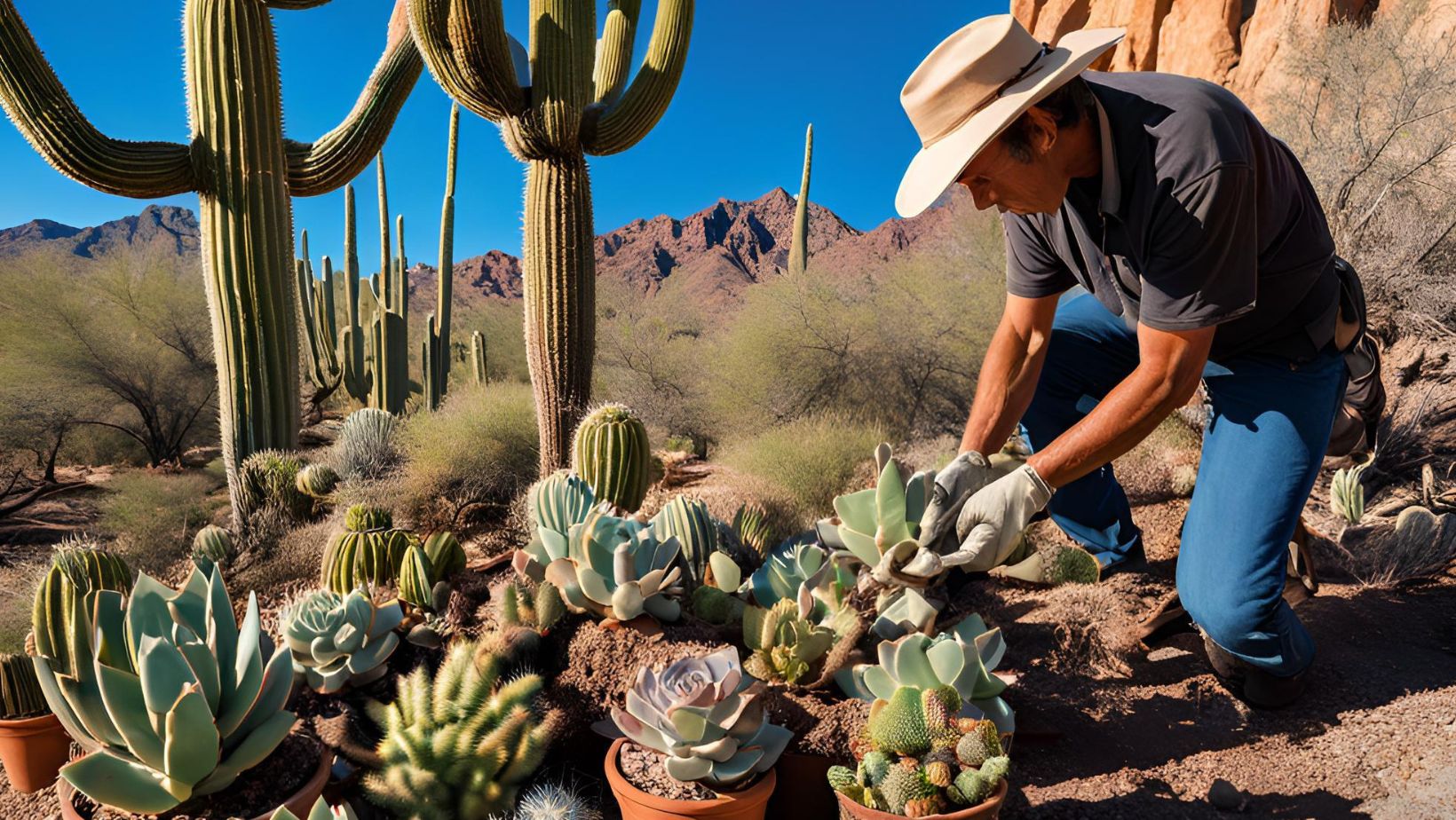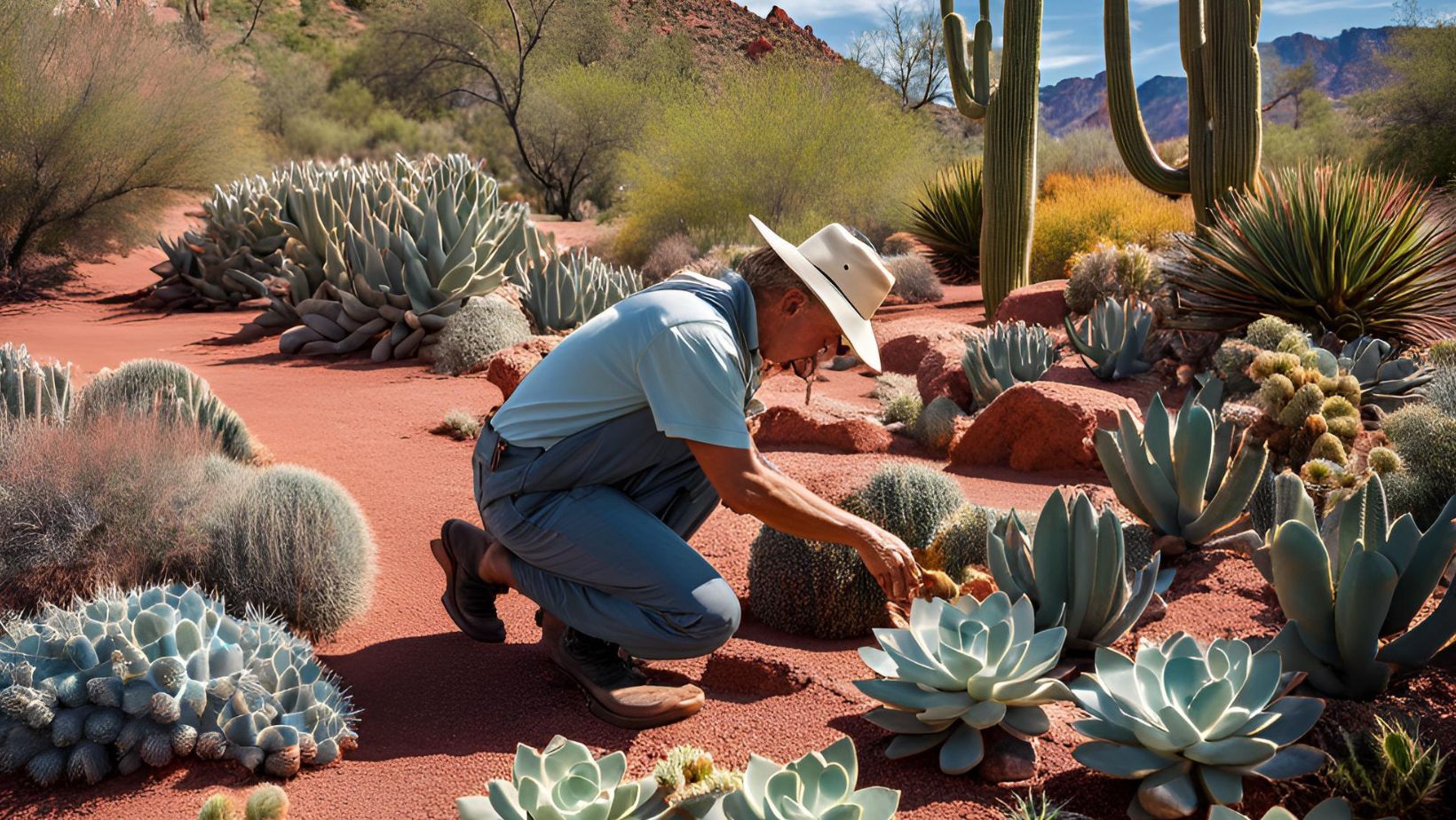
As an Arizona gardener for over a decade, I’ve learned that growing plants in the desert requires a unique approach. The intense heat, limited rainfall and alkaline soil create challenges that would make even experienced gardeners think twice. But I’ve discovered that with the right knowledge and techniques, you can create a thriving desert garden.
I’ll show you how gardening in Arizona works and how to work with Arizona’s distinct growing seasons and make the most of our climate zones. While many assume gardening is impossible in our harsh environment, I’ve found that native plants like prickly pear, desert marigold and sage flourish here naturally. Plus, with proper timing and preparation, you can successfully grow vegetables, herbs and even some fruits throughout the year. Let me share my tried-and-tested strategies for creating your own desert oasis.
Key Takeaways
- Gardening in Arizona requires adapting to unique conditions including intense heat, limited rainfall, and alkaline soil – but success is possible with proper techniques
- Arizona spans USDA zones 5a to 10b, with most desert regions falling in zones 9a-9b, allowing for diverse plant selection based on your specific location
- Essential elements for desert gardening success include proper soil amendments, efficient drip irrigation systems, and 3-4 inches of mulch for temperature regulation
- Native desert plants and heat-tolerant varieties like palo verde, lantana, and desert marigold thrive naturally, while carefully timed vegetable gardens can produce year-round
- Arizona has distinct growing seasons – plant warm-season crops February-April, heat-tolerant varieties June-August, and cool-season vegetables September-December
- Managing extreme heat through shade cloth, early morning watering, and proper plant placement is crucial for garden success in Arizona’s climate
Gardening in Arizona
Arizona’s climate creates distinct growing conditions that differ from traditional gardening environments. I’ve learned to adapt my gardening practices to work with these unique characteristics rather than against them.
Understanding Arizona’s Growing Zones
Arizona spans USDA hardiness zones 5a to 10b, creating diverse growing environments across the state. The lower desert regions around Phoenix fall into zones 9a-9b, while Tucson sits in zone 9a. Here’s how Arizona’s growing zones affect plant selection:
- Low desert zones (9a-10b) support heat-loving plants like citrus trees, bougainvillea, lantana
- Mid-elevation zones (7b-8b) accommodate deciduous trees, roses, herbs
- High desert zones (5a-7a) allow for cold-hardy plants like pine trees, apple trees, lavender
Adapting to Desert Weather Patterns
Desert weather follows predictable patterns that influence planting schedules and garden maintenance. The key weather elements I monitor include:
- Summer temperatures reaching 110°F+ from June through August
- Winter frost occurring December through February in zones 5a-8b
- Monsoon rains delivering 30-50% of annual rainfall between July and September
- Spring winds increasing moisture evaporation in March through May
| Season | Average High (°F) | Average Low (°F) |
|---|---|---|
| Summer | 105-110 | 75-85 |
| Winter | 65-75 | 40-45 |
| Spring | 75-85 | 50-60 |
| Fall | 85-95 | 60-70 |
Essential Desert Gardening Tools and Supplies
Desert gardening requires specific tools and materials to overcome the unique challenges of Arizona’s climate. I’ve compiled a comprehensive list of essential items based on my experience creating successful desert gardens.
Soil Amendments for Desert Gardens
Desert soil enrichment starts with organic matter to improve water retention and nutrient content. I mix these key amendments into my garden beds:
- Composted manure (2-3 inches) for nitrogen enrichment
- Peat moss (1-2 inches) to increase moisture retention
- Agricultural gypsum (5-10 pounds per 100 square feet) to break up clay soil
- Worm castings (1/2 inch layer) to add beneficial microorganisms
- Mulch (3-4 inches) to regulate soil temperature
| Amendment Type | Application Rate | Primary Benefit |
|---|---|---|
| Compost | 2-3 inches | Soil structure |
| Gypsum | 5-10 lbs/100 sq ft | Clay breaking |
| Mulch | 3-4 inches | Temperature control |
- Drip irrigation lines (1/4 to 1/2 inch) for targeted watering
- Smart controllers with rain sensors to automate watering schedules
- Pressure regulators (25-30 PSI) to prevent line damage
- Water meters to monitor consumption
- Moisture sensors to prevent overwatering
| Component | Specification | Water Savings |
|---|---|---|
| Drip Lines | 1/4-1/2 inch | 30-50% |
| Controllers | Smart system | 15-30% |
| Regulators | 25-30 PSI | 10-20% |
Best Plants for Arizona Gardens
After testing hundreds of plant varieties while gardening in Arizona, I’ve identified specific plants that thrive in our desert climate zones. These plants demonstrate exceptional tolerance to intense heat, limited water resources, and alkaline soil conditions.
Native Desert Plants and Succulents
Native desert plants form the backbone of my Arizona garden landscape. Here’s my tested selection of low-maintenance native plants:
- Palo Verde trees provide filtered shade with minimal water requirements
- Desert Marigold blooms continuously from spring through fall
- Red Bird of Paradise creates vibrant summer color displays
- Agave varieties offer architectural interest with 15+ year lifespans
- Barrel Cactus thrives in full sun exposure with monthly watering
- Desert Spoon tolerates temperatures from 0°F to 120°F
- Lantana maintains green foliage year-round in zones 9a-10b
Edible Plants That Thrive in Arizona
I’ve successfully grown these edible plants in my Arizona garden through multiple seasons:
- Citrus trees (zones 9a-10b):
- Lemons mature November-March
- Oranges produce December-April
- Limes fruit year-round
- Heat-tolerant vegetables:
- Armenian cucumbers grow in 100°F+ temperatures
- Malabar spinach replaces traditional spinach in summer
- Sweet potatoes thrive June-October
- Chile peppers produce heavy yields July-November
- Desert-adapted herbs:
- Rosemary maintains growth year-round
- Oregano spreads rapidly in partial shade
- Sage tolerates full sun exposure
| Plant Type | Water Needs | Sun Exposure | Growing Season |
|---|---|---|---|
| Native Plants | 1x/week | Full Sun | Year-round |
| Succulents | 1x/month | Full Sun | Year-round |
| Citrus | 2x/week | Partial Shade | Oct-April |
| Summer Vegetables | 3x/week | Morning Sun | March-Nov |
| Desert Herbs | 2x/week | Partial Shade | Year-round |
Seasonal Planting Guide for Arizona
Arizona’s distinct growing seasons create unique planting opportunities throughout the year. I’ve developed this guide based on 10+ years of desert gardening experience to help maximize growing success in each season.
Spring and Summer Planting Schedule
Spring planting starts in late February through April in low desert regions. I plant warm-season vegetables like:
- Plant tomatoes in February for harvest before intense summer heat
- Sow melons seeds in March when soil temperatures reach 70°F
- Transfer pepper seedlings in early April
- Add basil plants mid-April as temperatures stabilize
Summer planting occurs from June through August:
- Start heat-tolerant varieties like Armenian cucumbers in June
- Plant sweet potatoes slips in early July
- Sow okra seeds directly in July when soil reaches 85°F
- Transfer desert-adapted herbs like oregano in August
Fall and Winter Growing Season
Fall planting begins in September through November:
- Start leafy greens like kale in September
- Plant root crops such as carrots in October
- Transfer broccoli seedlings in late October
- Sow pea seeds in November when temperatures cool
- Plant garlic cloves in early December
- Sow spinach seeds in mid-December
- Transfer cabbage starts in late December
- Add cold-hardy herbs like cilantro in January
| Season | Temperature Range | Planting Window | Key Crops |
|---|---|---|---|
| Spring | 65-85°F | Feb 15 – Apr 30 | Tomatoes, Melons, Peppers |
| Summer | 85-110°F | Jun 1 – Aug 15 | Heat-tolerant Varieties |
| Fall | 65-85°F | Sep 1 – Nov 30 | Leafy Greens, Root Vegetables |
| Winter | 45-65°F | Dec 1 – Jan 31 | Cole Crops, Hardy Herbs |
Managing Common Garden Challenges
Gardening in Arizona desert climate presents distinct challenges that require specific solutions. Here’s how I manage the most significant issues in my desert garden.
Dealing with Extreme Heat
I protect my plants from intense summer heat using several proven methods:
- Install shade cloth with 30-50% density during peak summer months
- Create micro-climates using taller plants to shield smaller ones
- Apply 3-4 inches of organic mulch to keep root zones cool
- Water deeply in early morning hours before 6 AM
- Plant heat-sensitive crops on the east side of walls or structures
- Use light-colored containers to reflect heat
- Add temporary umbrellas over newly transplanted seedlings
- Monitor for leaf-footed bugs on tomatoes citrus from March through October
- Apply organic neem oil spray for aphids spider mites during spring months
- Install copper tape barriers to deter snails slugs from tender plants
- Place bird netting over fruit trees 2-3 weeks before harvest
- Create barriers with diatomaceous earth around susceptible plants
- Hand-pick tomato hornworms during evening inspection rounds
- Set up yellow sticky traps to catch whiteflies leafminers
- Release beneficial insects like ladybugs lacewings for natural pest control
| Common Desert Pest | Active Season | Primary Target Plants |
|---|---|---|
| Leaf-footed bugs | Mar-Oct | Tomatoes Citrus |
| Aphids | Feb-May | Vegetables Flowers |
| Tomato hornworms | Jun-Sep | Tomatoes Peppers |
| Whiteflies | Apr-Nov | Cole crops Cucurbits |
| Desert packrats | Year-round | Cacti Succulents |
Embracing Our Unique Climate
Gardening in Arizona may seem daunting but I’ve found that it’s entirely possible with the right approach. Through my years of desert gardening I’ve learned that success comes from embracing our unique climate rather than fighting it.
By selecting appropriate plants working with the natural seasons and implementing smart water management techniques you’ll be well on your way to creating a thriving desert garden. I encourage you to start small experiment with native plants and gradually expand your garden as you gain confidence.
Remember that every challenge in Arizona gardening has a solution. Whether you’re dealing with scorching summers or alkaline soil there’s always a way to adapt and succeed. With proper planning and the right techniques you too can enjoy a beautiful productive garden in our desert environment.





